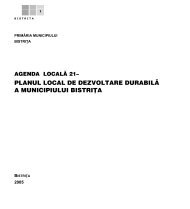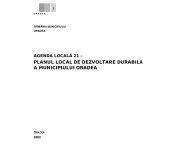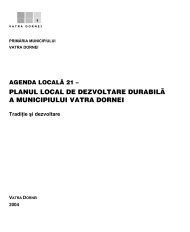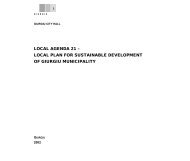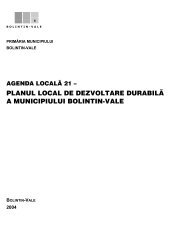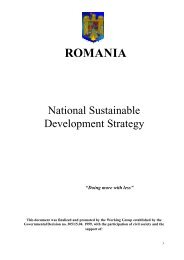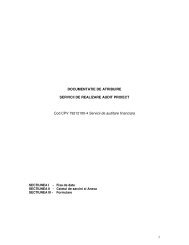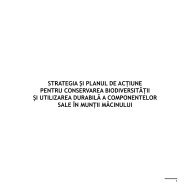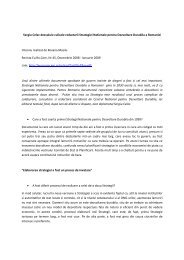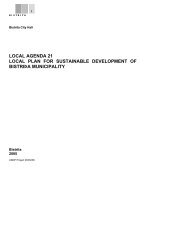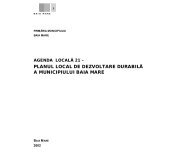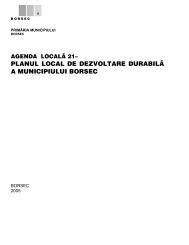Local Plan for Sustainable Development of Sibiu Municipality
Local Plan for Sustainable Development of Sibiu Municipality
Local Plan for Sustainable Development of Sibiu Municipality
You also want an ePaper? Increase the reach of your titles
YUMPU automatically turns print PDFs into web optimized ePapers that Google loves.
20<br />
MUNICIPALITY<br />
Sewage networks currently operational:<br />
- under 10 years 2 km<br />
- between 10-20 years 67 km<br />
- between 20-30 years 89 km<br />
- between 30-40 years 15 km<br />
- between 40-50 years 5 km<br />
- over 50 years 74 km<br />
STRONG POINTS<br />
Few <strong>of</strong> old debts <strong>of</strong> the beneficiaries <strong>of</strong> water supply and<br />
sewage services.<br />
Numerous available water sources, with sufficient flow.<br />
Very good relationship with water and materials suppliers.<br />
Very good drinking water quality.<br />
OPPORTUNITIES<br />
A new approach to the conservation and protection <strong>of</strong><br />
environmental activities (according to the Romanian policy<br />
<strong>for</strong> integration into the European Union).<br />
<strong>Development</strong> <strong>of</strong> an important investment programme <strong>for</strong> the<br />
water supply and sewage systems in <strong>Sibiu</strong>, the biggest part<br />
<strong>of</strong> the financing being provided by the European Union –<br />
ISPA Measure.<br />
Water Partnership with the city <strong>of</strong> Lauingen on the Danube<br />
River, with the support <strong>of</strong> the Bavaria Waters Office.<br />
<strong>Development</strong> <strong>of</strong> a modern water sources management.<br />
WEAK POINTS<br />
High level <strong>of</strong> water losses in network.<br />
The equipments and installations require great maintenance<br />
expenses, as well as investment funds.<br />
Insufficient trained personnel <strong>for</strong> development activities.<br />
Insufficient metering devices.<br />
RISKS<br />
Low level <strong>of</strong> population buying capacity.<br />
Decrease <strong>of</strong> local industrial activity, and implicitly <strong>of</strong><br />
expenditure.<br />
Lack <strong>of</strong> stability in legal system.<br />
Potential privatisation brings about inherent risks.<br />
Relationship with the Concurrence Office and the other<br />
governmental organisations involved.<br />
Economic environment with inflationist tendencies.<br />
Compulsions regarding the saving <strong>of</strong> drinking water.<br />
Compulsions from the pollution level <strong>of</strong> wastewaters.<br />
I.2.4. WASTE MANAGEMENT<br />
In 2002, 122,860 m 3 <strong>of</strong> waste were collected in <strong>Sibiu</strong>.<br />
From its source, municipal waste consists <strong>of</strong>:<br />
• domestic waste - 59%;<br />
• economic units waste - 27 %;<br />
• municipal services waste (streets, markets,<br />
green areas, mud from septic pits) - 14%.<br />
In 2002, a decrease in the quantity <strong>of</strong> waste was<br />
observed, due to the increase in the frequency <strong>of</strong><br />
waste collection and as well as the utilisation <strong>of</strong> metal<br />
and wrap waste, and the decrease <strong>of</strong> construction and<br />
demolition waste. Selective collection <strong>of</strong> domestic<br />
waste was experimented only in <strong>Sibiu</strong>, without<br />
conclusive results. Selective collected waste from the<br />
Hipodrom district was disposed <strong>of</strong> at the municipal<br />
landfill, without utilization. It appears that domestic<br />
waste contains great quantities <strong>of</strong> recyclable<br />
materials, such as glass, plastics, textiles and others.<br />
The implementation <strong>of</strong> a selective collecting system is<br />
imperative, as is the development <strong>of</strong> an infrastructure<br />
liable to increase the level <strong>of</strong> the use <strong>of</strong> recycled<br />
materials.<br />
Significant changes in waste composition were not<br />
noticed, except <strong>for</strong> the relative decrease in paper and<br />
cardboard waste. According to two studies carried out<br />
in <strong>Sibiu</strong>, the composition <strong>of</strong> collected domestic waste<br />
was the following:<br />
paper/cardboard 11 % 15.4%<br />
plastic 8% 15.2%<br />
glass 6% 3.8%<br />
metals 3% 2.8%<br />
textiles 3 % 4.3%<br />
organic materials 53% 42.7%<br />
others (inert) 16% 15.8%<br />
The disposal <strong>of</strong> domestic waste is carried out by<br />
depositing it on the ground, namely in a landfill which<br />
does not fulfil the requirements regarding environment<br />
protection. This landfill is not properly equipped,<br />
according the legislation, and it is a polluting source.<br />
Thus, the domestic waste landfill located on DJ 106<br />
<strong>Sibiu</strong> – Agnita, on the Remetea hill and established in<br />
1974, with an area <strong>of</strong> 5 ha and a waste storing volume<br />
<strong>of</strong> about 250,000 m 3 – had to be closed in 2003,



